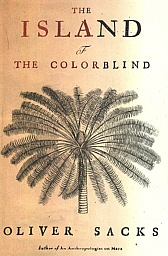

A READER'S JOURNAL
The Island of the Colorblind
by
Oliver Sacks
Published by Alfred Knopf in 1996
A Book Review by Bobby Matherne ©1997
Like Us? Subscribe to Receive a Monthly Email
Reminder of New Reviews & New DIGESTWORLD Issues — CLICK
~^~
Site Map: MAIN / A Reader's Journal, Vol. 2 Webpage Printer Ready


A READER'S JOURNAL
The Island of the Colorblind
by
Oliver Sacks
Published by Alfred Knopf in 1996
A Book Review by Bobby Matherne ©1997
Like Us? Subscribe to Receive a Monthly Email
Reminder of New Reviews & New DIGESTWORLD Issues — CLICK
~^~
Oliver Sacks had visual migraines as a child, not only the usual flashes of light and visual field alterations, but also occasional bouts of color blindness during which his color vision would weaken and even disappear for minutes at a time. Sacks' first book covered Migraines, so his latest book completes the symmetry by covering the colorblind aspect. His early periods of colorblindness led him to wonder what it would be like to have never seen colors at all: what subtle changes in habits and modes of operations one would evolve into. Recently, by chance, he discovered an island in the Pacific with almost ten percent of its population colorblind, and he became very interested in visiting this unique geographic isolate of achromatopsia.The island was Pingelap and its unique history created its high percentage of colorblindness. An atoll with no high ground, Pingelap was devastated by a typhoon hundreds of years ago, wiping out all but a handful of residents, who began to re-populate the island. The man who fathered most of the new children carried a recessive gene for achromatopsia, which found its way into all of his descendants and from them into the rest of the population.
The island of Pingelap evoked memories of Sacks' childhood readings of Omoo and Typee by Hermann Melville as well as the scientific accounts of the Pacific islands by Darwin and Wallace. He saw a chance to combine two childhood interests with a scientific expedition of his own and soon had lined up an ophthalmologist, Bob, and a Norwegian expert on achromatopsia, Knut to join him.
Knut, colorblind since birth, was a vision research scientist at the University of Oslo. Like all congenital achromatopes, Knut was without the use of the cones in the foveal region of his retina. The cones in the central region of his retina were either missing or non-functional. What the cones provide is the fine discrimination capability that allows one to read normal size text from up close and street signs from a distance. Knut kept around his neck both a magnifying glass for up close reading and a monocular for distance reading. The other aspect of achromatopsia is that the rods, being more sensitive to low levels of light, are overloaded by bright sunlight in the absences of the cones. This causes a white-out of achromatopes' visual fields in bright sunlight. To counteract this, Knut wore three pairs of sunglasses with very dark shades, one on top of the other, and this allowed him to see normally in the bright island sunshine.
The rods that surround the foveal area in a normal person provide excellent peripheral vision, a vision that is colorblind, sees well in low-light, and is sharply attuned to movement. When I am reading while I'm driving my car, it is my peripheral vision that I'm relying on to provide fast information of any traffic to my left or right that I must immediately attend to. The reader may wonder about the colorblindness of peripheral vision, as this is not what the world seems like to a normal color person. Our whole visual field seems colored, but careful tests have shown that color vision drops off sharply to the sides of our central foveal field, so that means our sense of a completely colored field of view is a carefully crafted illusion, that is, an extraordinary visual field construction of the brain. For night-driving most automobile drivers have learned to use their peripheral vision to discern movement and to discriminate low contrast objects in the dark. To be colorblind is like having only this low-light peripheral night-vision filling our entire visual field all the time.
Thus the achromatopes of Pingelap have much difficulty seeing in daytime — always squinting or wearing at times a black cloth over their heads as a crude filter. On the other hand they make excellent night-fishers or seamstresses working in dimly-lit rooms.
One non-vision related anomaly that Sacks noted was the universal craving for large quantities of Spam, the canned meat product, by the islanders. Added to the fruit and vegetable native fare it has turned an otherwise healthy, low-fat diet into a high-fat diet with all the attendant medical problems. One theory for the craving for Spam is that it has a porky taste similar to what the natives refer to as "long-pig" or human flesh. The more likely explanation, in light of the long since discontinued practice of cannibalism, is that Spam provides every native islander a daily chance to eat a food, pork, a meat that was once reserved for royalty. Spam to them is like white bread to us in the more civilized societies. This bread uses a highly refined wheat that originally required so much effort to produce that only aristocrats and the very rich could afford to eat the white bread made with it. Now blue collar workers carry white bread sandwiches to work every day for lunch. Only recently has the nutritional deficits of white bread been highlighted to the point where whole wheat breads are becoming common again.
In the second half of his book, Sacks makes another trip to the Pacific, this time to the islands of Guam and Rota, to investigate a puzzling neurological disease called lytico-bodig. This disease takes one of two forms: lytico — a progressive paralysis, or bodig — a form of Parkinson's Disease. One would expect that Sacks would help discover the etiology of this disease, as he devotes so much space to discussing the research, the epidemiology, the case histories, the theories, etc, but no such luck. This is not a scientific thriller like The Andromeda Strain or Outbreak in which scientists rush against time and find a solution, but rather it is a real-life enigma that remains as puzzling at the end of the story as it was at the beginning. Sacks merely observes and records what he finds. He is like a jigsaw puzzle assembler: he pulls all the pieces together, forms the edges of the puzzles, fills in some key areas, and leaves the rest for others to complete.
One long suspected source of the disease is from eating the fruits of the cycads that flourish on the islands of Guam and Rota. Cycads are remnants of the ancient Mesozoic forests that we know today as common ferns and sago palms. On Rota, huge forests of these cycads, resembling palm trees, still exist in a geographic isolate. The natives have long eaten the fruit and roots of these plants in various forms, all of which require careful preparation to wash away highly toxic alkalines.
As a child, Sacks was enamored by the cycads that he found growing in botanical gardens in England, and even attempted to raise some on his own. His visit to these two geographic isolates of cycad and lytico-bodig allowed him to combine yet another childhood fascination with his adult profession. (The common sago palm indigenous to my local area of New Orleans is, I was surprised to find out from Sacks, a cycad.)
Like a modern day Dr. Doolitte, Dr. Sacks travels around the world having wonder-full adventures which he writes about and invites us all to join in. Whether visiting geographical isolates of disease and plant life or exploring the cognitive isolates of his childhood dreams, or both, he communicates a sense of delight and discovery that always leaves us wanting more.
~^~BOOKS by OLIVER SACKS
Click to Read Review
1. The Island of the Colorblind
2. Uncle Tungsten — Memories of a Chemical Boyhood
3. Musicophilia — Tales of Music and the Brain
4. An Anthropologist on Mars — Seven Paradoxical Tales
5. On the Move — A Life
6. A Leg To Stand On — A Neurography
7. Gratitude
8. The Mind's Eye
To Be Reviewed
9. Seeing Voices — A Journey into the World of the Deaf
10. Awakenings — A newly revised edition of the medical Classic
11. The Man Who Mistook His Wife for a Hat — A Collection of Neurographies
12. Migraine
13. Hallucinations
14. Oaxaca Journal


Click Left Photo for List of All ARJ2 Reviews Click Right Bookcover for Next Review in List Did you Enjoy this Webpage?
Subscribe to the Good Mountain Press Digest: Click Here!


CLICK ON FLAGS TO OPEN OUR FIRST-AID KIT.
Do you feel like you're swimming against a strong current in your life? Are you fearful? Are you seeing red? Very angry? Anxious? Feel down or upset by everyday occurrences? Plagued by chronic discomforts like migraine headaches? Have seasickness on cruises? Have butterflies when you get up to speak? Learn to use this simple 21st Century memory technique. Remove these unwanted physical body states, and even more, without surgery, drugs, or psychotherapy, and best of all: without charge to you.
Simply CLICK AND OPEN the
FIRST-AID KIT.

